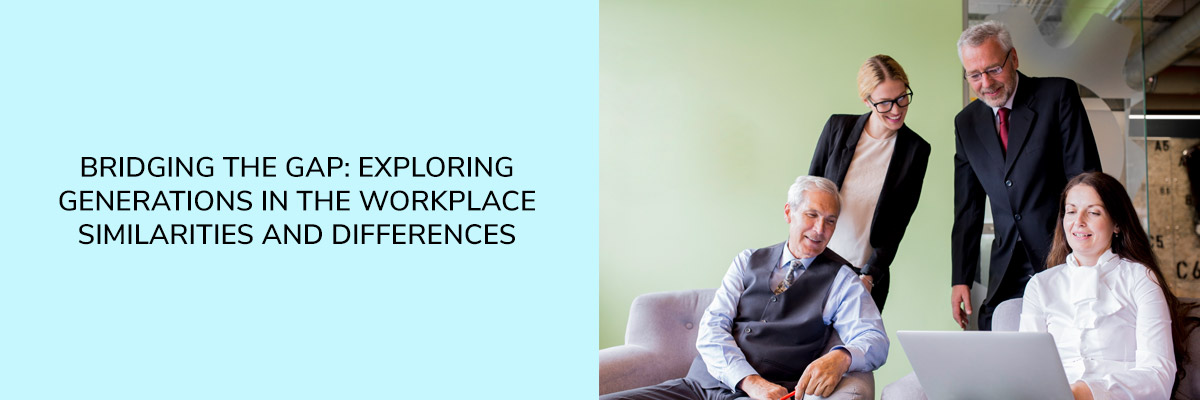The modern workplace is a melting pot of diverse generations working side by side, each with their unique perspectives, values, and experiences. From the Baby Boomers to Generation X, Millennials, and Generation Z, there is a significant generational mix in today’s workforce.
This diversity can sometimes lead to challenges for organizations, as all generations have different personality types, preferences, and expectations from the organizations. Join our upcoming webinar to learn how to address workplace diversity challenges and effectively manage difficult employees.
Leaders can turn challenges into opportunities by showing understanding and empathy. They can use their emotional intelligence and problem-solving skills to create a productive and harmonious workplace.



In this blog, we will explore the similarities and differences among these generations and discuss how we can harness their strengths to build a thriving work environment.
The Generations in the Workplace:
So, let’s first understand the different generations that are currently working in the workforce.
- Baby Boomers (1946-1964): They are known for their strong work ethic, loyalty to their employers, and resilience. They grew up during a time of economic growth and were heavily influenced by the social changes of the 1960s and 1970s.
- Generation X (1965-1980): They have witnessed the rise of technology and experienced economic shifts that impacted their career paths. They tend to be independent, and adaptable, and value a work-life balance.
- Millennials (1981-1996): Also known as Generation Y, are the first true digital natives. They grew up with the internet and rapidly evolving technology. They are often associated with a desire for purposeful work, collaboration, and a flexible work environment.
- Generation Z (1997-2012): The newest generation to enter the workforce, Generation Z, is characterized by their comfort with technology and social media. They are diverse, entrepreneurial, and seek job stability, and they also value work-life balance and more perks.
Understanding the Similarities:
Despite the different backgrounds and experiences, these generations share some common traits that can be harnessed to create a cohesive workplace culture:
- Desire for Meaningful Work: All generations seek meaning and purpose in their jobs. They want to feel that their work contributes positively to the world, whether through innovation, social impact, or personal growth.
- Professional Growth: All employees, regardless of age, value opportunities for career development and advancement. Providing training, mentorship, and growth paths can improve engagement and retention across generations.
- Work-Life Balance: Achieving a healthy work-life balance is a universal aspiration. Employers who prioritize employee well-being and offer flexible work arrangements can appeal to employees of all ages.
- Respect and Inclusion: Respectful communication and fostering an inclusive environment are essential for all generations. Everyone wants to feel valued and respected in the workplace, regardless of their age.
Embracing the Differences:
Understanding the distinct characteristics of each generation is crucial for creating a workplace that effectively utilizes the strengths of all employees:
- Multigenerational Mentorship: Encouraging mentorship programs that pair older and younger employees can facilitate knowledge sharing and skill development. Older workers can offer valuable experience, while younger ones bring fresh perspectives and technological know-how.
- Communication Styles: Different generations have different preferences when it comes to communication channels. Older generations might prefer face-to-face interactions, while Millennials and Gen Z might be more inclined towards instant messaging and collaboration tools. Organizations should accommodate these preferences to improve communication efficiency.
- Approach to Technology: While younger generations are typically tech-savvy, older generations might have different levels of comfort with digital tools. Offering technology training for older employees can help them feel more confident and adaptable in the digital age.
- Recognition and Rewards: Each generation may appreciate different forms of recognition. Older generations may prefer public acknowledgment, while Millennials and Gen Z might respond well to personalized rewards or opportunities for advancement.
Building an Inclusive Workplace:
Creating an inclusive workplace that values the unique contributions of each generation requires intentional effort:
- Promote Diversity and Inclusion: Foster an inclusive culture that celebrates diversity and encourages open dialogue. Respect and value the different perspectives and experiences that each generation brings to the table.
- Flexibility in Policies: Implement flexible policies that cater to the needs of different generations. This could include flexible working hours, remote work options, or phased retirement programs for older employees.
- Open Communication Channels: Encourage open communication and feedback among all employees. Regularly seeking input from each generation can help identify challenges and opportunities for improvement.
- Continuous Learning: Provide learning opportunities for employees of all ages to enhance their skills and stay updated on industry trends. This will benefit both the individuals and the organization as a whole.
Conclusion:
Bridging the generational gap in the workplace requires a combination of understanding, flexibility, and empathy. By recognizing and appreciating the similarities and differences among generations, organizations can build a harmonious and productive work environment and positive work behavior. Embracing diversity and leveraging the strengths of each generation improves collaboration, innovation, and overall success in today’s business landscape.


